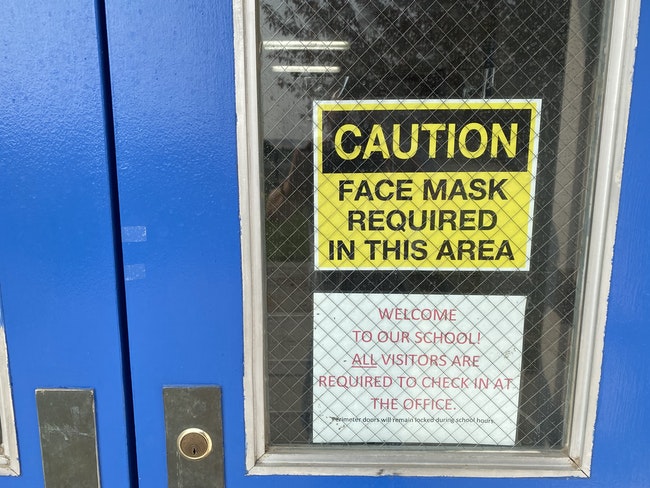
New school Covid standards announced last week will allow some schools in the state to reopen. (The Enterprise/Les Zaitz).
SALEM – Gov. Kate Brown set a new target for Malheur County to get students back to regular schooling, but it won’t be easy to hit.
Malheur County is one of two in the state experiencing such high infection rates of the coronavirus that distance learning is going to be prime way to teach for now.
That means several districts can continue limited in-person classes – restricted to two hours a day – but putting every student fully back in a classroom instead of in front of a computer won’t happen soon.
Brown and Colt Gill, director of the Oregon Education Department, last week announced the latest revision to state rules governing schools.
They offered little change for Malheur County schools, though those providing the limited class time can now teach 20 kids in a class instead of 10. School districts are assessing what that could mean for more teaching time.
At Four Rivers Community School in Ontario, the 220 students will get this week off from even the limited classes so school officials can assess what to do with the new state measures.
“Four Rivers wants to be part of the solution for the county to bring down the numbers so we can get kids back in session,” said Superintendent Chelle Robins. “We are concerned about students’ current and long-term emotional wellbeing and academic growth.”
Alisha McBride, Vale School District superintendent, said all Vale students can attend school twice a week for two hours a day. She plans to work with her staff and the Vale School Board to consider additional changes, including expanding total hours to eight per week.
State records show part-time attendance at 354 for Vale Elementary School, 72 for Willowcreek Elementary, 111 for Vale Middle School and 246 for Vale High School.
The Ontario School District this week started returning some students for limited classes, such as welding students at Ontario High School.
“We’re trying to ease ourselves into it,” said Superintendent Nikki Albisu. “We’re doing it cautiously and thoughtfully.”
In Nyssa, students are attending limited in-person classes and Superintendent Darren Johnson hopes to expand that. State records show part-time attendance at 72 for elementary, 25 for middle school, and 100 for high school.
“We are not able to meet the metrics for returning to full in-person or the hybrid instructional model for the foreseeable future,” Johnson said.
Adrian students in kindergarten through third grade and middle and high school students can attend two-hour classes daily, according to Superintendent Kevin Parnell. Grades 4 through 6 aren’t yet on a daily schedule. The state showed 170 students attending the in-person classes.
Smaller, remote school districts started the school year in normal operation. The Jordan Valley School District reported 56 students, Annex Community School had 59 and Arock had 17.
The new state measures ease up on some restrictions, providing an opening for more schools to return to near-normal operations. Across Oregon, Gill said, an estimated 130,000 students are in districts that qualify to resume normal operations.
The new measures, however, remain out of reach for Malheur County.
Schools can reopen if the rate of cases measured per 100,000 population over two weeks is between 50 and 100. As of Oct. 24, the state listed Malheur County with a comparable case rate of 446 – four times what would allow schools to resume.
Schools also can reopen if the actual number of new cases over a two-week period is less than 45. As of Oct. 24, the state showed Malheur County with 143 cases.
The state also wants the percentage of tests for Covid coming back positive as less than 8%. Malheur County’s rate has been about 21%.
The Governor’s Healthy Schools Reopening Council recently considered the need to modify the state’s rules, meeting ahead of the state’s announcement. State officials considered experiences in other states with more liberal standards for in-person teaching.
Lisa Longoria, Ontario Middle School principal and member of the council, said educators, health officials and parents realize the value of getting students back into classrooms. The high rates of community spread of the coronavirus remain a roadblock.
“Everyone wants kids back in school but not everyone wants to do what it takes to get the numbers down,” Longoria said. “That’s really unfortunate.”
During the council discussion, there was a “lot of concern” about the desire to reopen schools clashing with the impact of people not wearing masks, social distancing and taking other precautions to slow the virus.
“If we can’t get the numbers down, we can’t get kids back in school,” she said.
Under current state rules, schools without Covid cases can return students to limited class time. In Malheur County, that means no more than 10 in a class and usually meeting for no more than two hours. Virtual distancing over the internet remains the primary way to teach.
Roberto Gamboa of Euvalcree, who also serves on the governor’s council, said the group discussed how to loosen the state’s rules “so in-person school can be a little more attainable.” He said that might be a slow expansion in school hours but even that could get students “more involved in schooling than they have been.”
In a statement after the council meeting, the governor noted that children get more than lessons from school. They often rely on schools for meals and health care.
“Unfortunately, too many students do not have a stable place to call home,” Brown said. “These are the kids who need in-person instruction the most, the kids for whom a smile in a classroom or a helping hand in the lunchroom means everything.”
Brown’s statement said the council found a “major concern” with equal access to distance learning, noting the pandemic has had a more significant impact on minorities, including Latinos.
Gamboa said distance learning is particularly challenging in rural communities such as Malheur County.
“There was a lot of concern for a lot of children not getting a very good education,” Gamboa said.
One limit is access to internet services for students to join virtual classes.
Longoria said the Ontario School District has a special team to help arrange internet service and work with parents on virtual schooling questions.
“Nobody gets lost in the shuffle,” she said.
She said schools are providing students more ways to catch classwork besides joining a virtual class. She said family circumstances vary home to home, so some students are tending to siblings instead of going to class or sleeping because of their job schedule.
But such independent study isn’t always effective.
“Working on their own isn’t the best option all the time,” Longoria said.
Gamboa said closed schools means parents are faced with unexpected needs for someone to care for their children while they work.
“Parents are paying quite a bit in child care expenses,” he said. “It’s a larger need that’s not been fully met.”
He said state regulations and limits on child care slots could be changed to allow for more child care services, he said.
He also said another challenge is for students from Spanish-speaking homes. He said there are limits to how much school material is translated into Spanish.
“Those students have to go and receive special services in order to receive an education,” Gamboa said.
He said there aren’t enough Spanish-speaking teachers.
“There’s no way they can meet the great need of all the students needing assistance,” he said.
Contact Editor Les Zaitz by email at [email protected].
YOU CAN HELP KEEP LOCAL NEWS FLOWING: Reader support allows the Enterprise to provide in-depth, accurate reporting that otherwise would not get done. Keeping the community well informed is essential. SUBSCRIBE – $5 a month, automatically. DONATE – to provide additional support.




